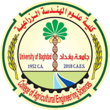The College of Agricultural Engineering Sciences discusses methods for examining the quality of wheat grain upon receipt in silos.
The College of Agricultural Engineering Sciences, University of Baghdad, discussed a master’s thesis titled (A study of different methods for determining the purity of wheat grain upon receipt in different silos)) by the student (Mohammed Salman Jassim Al-Amiri) in the Department of Agricultural Machines and Equipment.
The study aimed to evaluate the performance of the methods used in receiving grain in different silos to find out the most accurate method used and to compare the obtained results.
The study concluded that the characteristics of hardness and grain size are among the most important factors that determine the quality of grains, and that sorting and grading grains can be done through the external shape of the grain or what is called phenotypic diagnosis. The study also showed that using modern mechanization to sort and evaluate grain quality is better than using the manual method due to the speed and accuracy of the first method. The purity of the grain differs from one location to another according to the source of grain production and the location of the silo. The geographical area of the region and the nature of the cultivated land have an impact on the quality of the grain.
The researcher recommended the use of fast and modern techniques to detect the purity of grain and evaluate its quality in a better way, such as the use of machines for cleaning and sifting grain known scientifically with high efficiency and not being satisfied with traditional methods of sifting and cleaning grain. As well as adding new tests such as hardness, grain size, and 1000 grain weight to evaluate grains and their quality. The researcher also recommended using the hectoliter device with a capacity of 1000 milliliters instead of other capacities, as it gives a direct measurement without the need for calculations for unit conversion, and the use of a digital grain moisture check device that gives accurate readings of the grain moisture content with the protein percentage to shorten the time.

